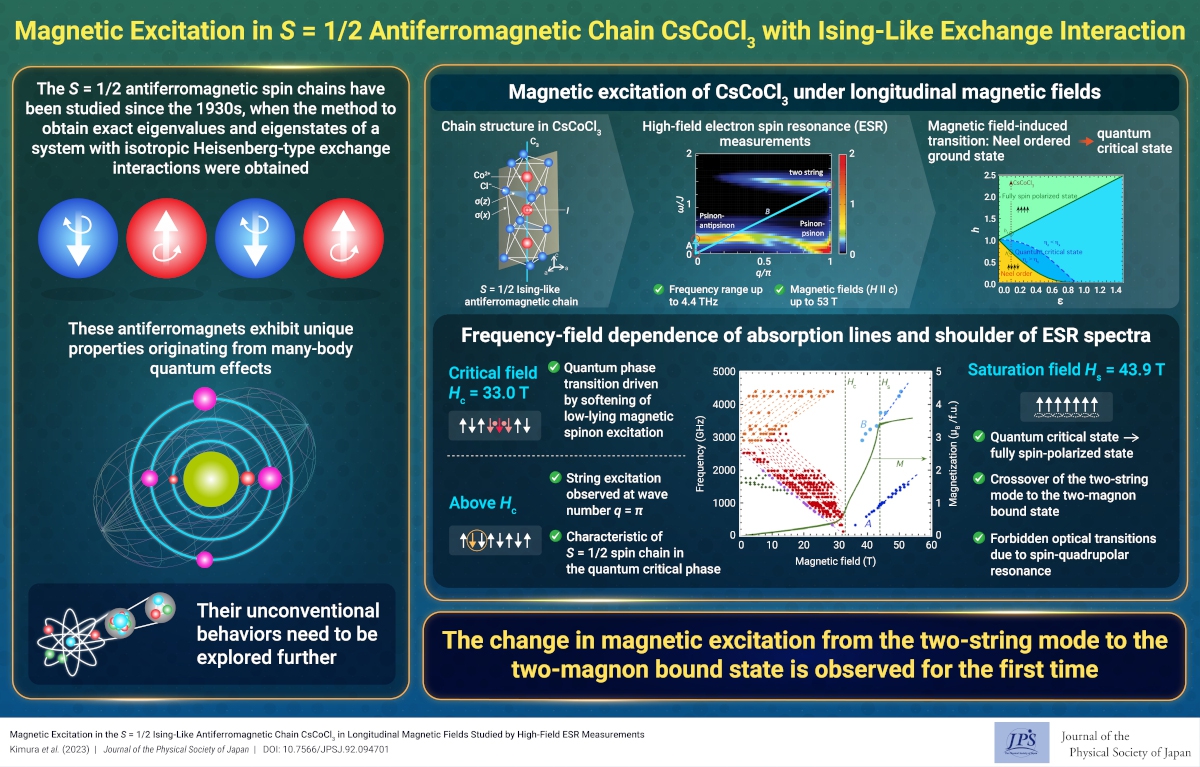Magnetic Excitation in S = 1/2 Antiferromagnetic Chain CsCoCl3 with Ising-Like Exchange Interaction
© The Physical Society of Japan
This article is on
Magnetic Excitation in the S = 1/2 Ising-like Antiferromagnetic Chain CsCoCl3 in Longitudinal Magnetic Fields Studied by High-field ESR Measurementss
(JPSJ Editors' Choice)
J. Phys. Soc. Jpn. 92, 094701 (2023).
The results of high-field electron spin resonance measurements in the millimeter-wave to terahertz region reveal unconventional magnetic excitation in S = 1/2 one-dimensional antiferromagnets.

The one-dimensional antiferromagnet with spin S = 1/2 has been studied since 1931 when H. Bethe proposed a method to obtain the exact eigenvalues and eigenstates of a system with isotropic Heisenberg-type exchange interactions. Research has revealed that the simple S = 1/2 one-dimensional antiferromagnet exhibits rich and exotic properties originating from the many-body quantum effects. In the case of the most-investigated system with isotropic Heisenberg-type interactions, the quantum fluctuations destroy the long-range order, leading to a quantum critical state with algebraic decay of the spin correlation function. The magnetic excitation from this fluctuating ground state exhibits a marked contrast from that of the classical spin wave. The lowest-energy excitation in the S = 1/2 one-dimensional antiferromagnet is a pair excitation of quasi-particles called spinons, which are mobile domain walls created by flipping the spins from its ground state. Under external magnetic fields, the magnetic excitation becomes gapless at incommensurate wave numbers in the reciprocal lattice space. In addition, recent theory has indicated that the string states, which are characterized by complex rapidities in the Bethe-anzats calculations, change asymptotically to multimagnon bound states upon increasing the field, significantly contributing to the excitation spectrum.
We investigated the magnetic excitation in the S = 1/2 one-dimensional antiferromagnet with Ising-like anisotropy CsCoCl3 through high-field electron spin resonance (ESR) spectroscopy in a wide frequency region from 130 GHz to 4.4 THz under pulsed magnetic fields up to 53 T. In contrast to the Heisenberg-type system, the antiferromagnetic order is maintained in the ground state of the S = 1/2 Ising-like one-dimensional antiferromagnet at zero magnetic field, owing to magnetic anisotropy. However, by applying the magnetic field along the magnetic easy axis, the system transitions into the quantum critical state. Our ESR results demonstrate that the softening of the spinon by the external magnetic field drives this field-induced transition. This result suggests that the antiferromagnetic order is destroyed by the propagating domain walls induced in the ground state by the longitudinal magnetic field. Thereby, the spin chain is brought into the quantum-critical state with no long-range order. In the quantum critical state, we observe the appearance of a two-string state in the terahertz region above 2.9 THz. By increasing the magnetic fields further, to the saturation field, we can successfully observe the change in the magnetic excitation from the two-string to the two-magnon bound state, for the first time.
(Written by Shojiro Kimura on behalf of all the authors)
Magnetic Excitation in the S = 1/2 Ising-like Antiferromagnetic Chain CsCoCl3 in Longitudinal Magnetic Fields Studied by High-field ESR Measurementss
(JPSJ Editors' Choice)
J. Phys. Soc. Jpn. 92, 094701 (2023).
Share this topic
Fields
Related Articles
-
Exploring Electronic States in BEDT-TTF Organic Superconductors
Superconductivity
Electronic transport in condensed matter
Magnetic properties in condensed matter
2024-4-24
This review, published in the Journal of the Physical Society of Japan, provides a comprehensive summary of the electronic states observed in BEDT-TTF type organic superconductors, including metal-insulator transitions, Mottness transitions, non-Fermi liquids, quantum spin liquids, and Bose-Einstein condensation.
-
Variety of Mechanically Induced Spin Currents in Rashba Systems
Electronic transport in condensed matter
Magnetic properties in condensed matter
Structure and mechanical and thermal properties in condensed matter
2024-3-22
Various types of spin currents, including unconventional types, are generated in Rashba spin-orbit coupled systems by dynamic lattice distortions associated with, for example, surface acoustic waves.
-
Current Melt Frozen Electrons
Dielectric, optical, and other properties in condensed matter
Magnetic properties in condensed matter
2024-1-15
The origin of the current-induced insulator-to-metal transition of samarium monosulfide was explained by the 4f−5d hybridization observed using optical reflectivity and photoelectron spectroscopies.
-
Towards Uncovering the Hidden Order of URu2Si2 Phase Transition
Magnetic properties in condensed matter
Electronic structure and electrical properties of surfaces and nanostructures
2024-1-11
We propose a chiral charge as the hidden order parameter in URu2Si2 and present experiments to detect it by focusing on breakings of mirror and inversion symmetries at the local uranium ion.
-
Strange Elastic Anomalies with Ultraslow Dynamics around Magnetic Critical Endpoint
Structure and mechanical and thermal properties in condensed matter
Magnetic properties in condensed matter
2023-11-2
Near the magnetic critical endpoint of UCoAl, peculiar elastic anomalies exhibiting exotic ultraslow dynamics arising from electric quadrupoles are indicated. Combining this with diverse fluctuations, intriguing phenomena and exotic ground states are expected.
